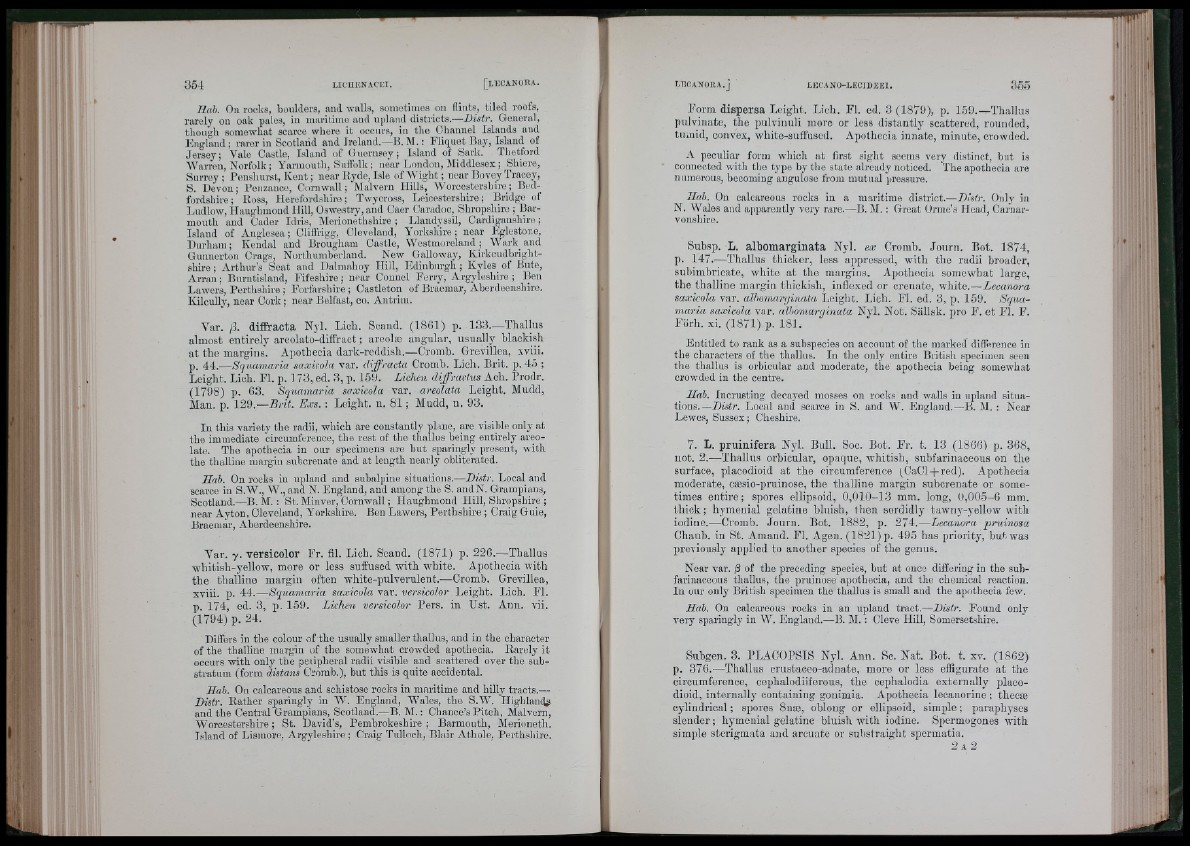
•( !■
Ilah. On rocks, boulders, and walls, sonietiiues on (lints, tiled roofs,
rarely ou oak pales, iu maritime and upland districts.—D k tr . General,
tbougli sonieivliat scarce where it occurs, in the Channel Islands and
Kngland; rarer in Scotland and Ireland.—B. M. : Fliquet Bay, Island ot
Jersey; Vale Castle, Island of Guernsey; Island of Sark. Thetford
Warren, Norfolk ; Yarmouth, Sufiolk; near London, Middle.sex ; Shiere,
Surrey ; Peuslmrst, Kent ; near Hyde, Isle of Wight ; uear Bovey Tracey,
S. Devon; Penzance, Cornwall; Malvern Hills, Worcestersliire; Bedfordshire;
Ross, Herefordshire; Twycross, Leicestersliire; Bridge of
Ludlow, Ilaughmond Hill, Oswestry, and Caer Caradoc, Shropshire; Barmouth
and Cader Idris, Merionethshire ; IJandyssil, Cardiganshire ;
Island of Anglesea; Cliffrigg, Cleveland, Yorkshire; near Kglestone,
Durham; Kendal and Brougliam Castle, Westmoreland; Wark and
Qimuertoii Crags, Nortlmniberland. New Galloway, Kirkcudbrightshire
; Arthur’s Seat and Dalmahoy Hill, Edinbiirgli ; Kyles^ of Bute,
Arran; Burntisland, Eitesliire; near Connel Ferry, Argyleshire; Ben
Irewers, Perthshire ; Forfarshire ; Castleton of Braemar, Aberdeenshire.
Kilcul/v, near Cork ; near Belfast, co. Antrim.
Var. ft. diffracta Nyl. Lioh. Scand. (1861) p. 133.—Thallus
almost entirely areolato-diffract ; areolæ angular, usually blackish
a t th e margius. Apothecia dark-reddish.—Cromb. Grevillea, xviii.
p. 44.—Squamaria saxicola var. diffracta Cromb. Lioh. Brit. p. 45 ;
Loight. Lioh. F l. p. 173, ed. 3, p. 159. Lichen diffcactus Aoh. Prodr.
(1798) p. 63. Squamaria saxicola var. areolata Leight. Mudd,
Man. p. 129.—B rit. Exs. : Leight. n. 81 ; Mudd, n. 93.
In this variety the radii, which are constantly plane, are visible only at
the immediate circumference, the rest of the thallus being entirely areolate.
The apothecia in our specimens are hut sparinglv present, with
the thalliue margin suborenate and at length nearly obliterated.
Ilah. On rocks in upland and suhalpine situations.—Distr. Local and
scarce in S.W., W., and N. England, aud among the S. andN. Grampians,
Scotland.—B. M. ; St. Minver, Cornwall ; Ilaughmond Hill, Shropshire ;
near Ayton, Cleveland, Yorkshire. Ben Lawers, Perthshire ; Craig Guie,
Braemar, Aberdeenshire.
Var. y . versicolor F r. fil. Lioh. Soand. (1871) p. 226.— Thallus
whitish-yellow, more or less suffused w ith white. Apotheoia with
th e thalline margin often white-pulverulent.— Cromb. Grevillea,
xviii. p. 44.—Squamaria saxícola var. versicolor Leight. Lich. Fl.
p. 174, ed. 3, p. 159. Lichen versicolor Pers. in Ust. Ann. vii.
(1794) p. 24.
Differs in the colour of the usually smaller thallus, and in the character
of the thaUine margin of the somewhat crowded apothecia. Rarely it
occurs with only the peiipheral radii visible and scattered over the substratum
(form distans Cromh.), but this is quite accidental.
Hah. On calcareous and schistose rooks in maritime and hilly tracts.—
Distr. Rather spariugly in W. England, W'ales, the S.W. Highlamfg
and the Central Grampians, Scotland.—B. M. : Chance’s Pitch, Malvern,
Worcestershire ; St. David’s, Pembrokeshire ; Barmouth, Merioneth.
I.sland of Lismore, Argyleshire ; Craig Tulloch, Blair Athole, Perthshire.
Form d isp e rs a Leight. Lich. Fl. ed. 3 (1879), p. 159.—Thallus
pulvinate, th e pulvinuli more or less distantly scattered, rounded,
tumid, convex, white-suffused. Apothecia innate, minute, crowded.
. \ peculiar form which at first sight seems very distinct, but is
connected with the type by the state already noticed. The apothecia are
numerous, becoming angulose from mutual pressure.
Hah. On calcareous rocks in a maritime district.—Distr. Only in
N. Wales and apparently very rare.—B. M. : Great Orme’s Head, Carnarvonshire.
Subsp. L. a lh om a rg in a ta Nyl. ex Cromb. Journ. Bot. 1874,
p. 147.—Thallus thicker, less apprcssed, with th e radii broader,
subimbricato, white a t the margins. Apotheoia somewhat large,
th e thalline margin thickish, inflexed or crenate, white.— Lecaiwra
saxicola var. alhomaryinata Loight. Lioh. Fl. ed. 3, p. 159. Squamaria
saxicola var. alhomarginata Nyl. Not. Sallsk. pro F. e t F l. F.
Fo rh . xi. (1871) p. 181.
Entitled to rank as a subspecies on account of the marked difference in
tlie characters of the thallus. In the only entire British specimen seen
the thallus is orbicular and moderate, the apothecia being somewhat
crowded iu the centre.
Hab. Incrusting decaj’ed mosses on rocks and walls in upland situations.—
Distr. Local and scarce iu S. and W. England.—B. M. ; Near
Lewes, Sussex ; Cheshire.
7. L. p ru in if e r a Nyl. Bull. Soo. Bot. F r. t. 13 (1866) p. 368,
not. 2.— Thallus orbicular, opaque, whitish, subfarinaceous on the
surface, placodioid a t tho circumference (CaCl J-red ). Apothecia
moderate, oæsio-pruinose, the th allin e margin suborenate or sometimes
entire ; spores ellipsoid, 0 ,0 1 0 -1 3 mm. long, (J,00 5 -6 mm.
th io k ; hymenial gelatine bluish, th en sordidly tawny-yellow u ith
iodine.—Cromb. Journ. Bot. 1882, p. 2 7 4.— Lecanora pruinosa
Chaub. in St. Amaud. F l. Agen. (1821) p. 495 has priority, b u t was
previousl}' applied to a n o th e r species of the genus.
Near var. ft of the preceding species, but at ouce differing in the sub-
farinaceous thallus, the pruinose apothecia, and the chemical reaction.
In our only British specimen the thallus is small and the apothecia few.
Hab. On calcareous rooks in an upland tract.—Distr. Found only
very sparingly in W. England.—B. M. ; Cleve Hill, Somersetshire.
Subgen. 3. BLACOPSIS Nyl. Ann. Se. Nat. Bot. t. xv. (1862)
p. 3 76.—Thallus erustaceo-adnate, more or less eiftgurate a t the
circumference, cephalodiiferous, th e cephalodia externally jdaco-
dioid, in ternally containing gonimia. Apotheoia lecanorine ; thecæ
eylindrioal ; spores 8næ, oblong or ellipsoid, simple ; paraphyses
slender ; hymenial gelatine bluish with iodine. Spermogones Avith
simple sterigmata aud arcuate or substraight spermatia.
2 a 2
* ‘